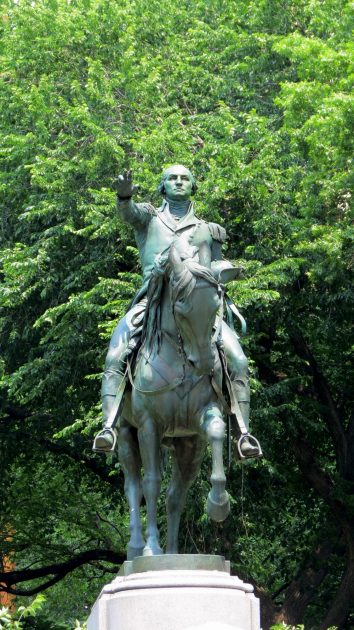Home | Washington, George
- CountryUS
- Town:NY New York City
-
Year of creation:1856
- Rider(s):Washington, George
(1732–1799) was born into a prosperous family in Virginia. He was privately educated and gained experience as a land surveyor before joining the militia. From 1755 to 1758 he served as an officer in the French and Indian War. After rising to the rank of colonel, he resigned his post and married Martha Dandridge, returning as a gentleman farmer to the family plantation at Mount Vernon, Virginia. He soon re-entered public life and served as a member of the First and Second Continental Congress (1774–1775). On the outbreak of the American Revolutionary War in 1775, Washington was made Commander-in-Chief of the Continental Army. His military prowess and inspirational leadership held the colonial armies together against overwhelming odds, and secured the evacuation and defeat of the British in 1783. Washington again retired to Mount Vernon, but his dissatisfaction with the new provisional government caused him to resume an active role, and in 1787, he presided over the second federal constitutional convention in Philadelphia. He was unanimously chosen as the first President of the United States, and was inaugurated in New York City in 1789. Washington was re-elected to a second term in 1793, declined a third term, and retired from political life in 1797. As US President, he oversaw the creation of a strong, well-financed national government that maintained neutrality in the wars raging in Europe, suppressed rebellion and won acceptance among Americans of all types. His leadership style established many forms and rituals of government that have been in place since, such as using a cabinet system and delivering an inaugural address. Washington is universally regarded as the ‘father of his country’. As the leader of the first successful revolution against a colonial empire in world history, Washington became an international icon for liberation and nationalism, especially in France and Latin America.
- Sculptor(s):Brown, Henry Kirke
(1814–1886) and his nephew Henry Kirke Bush-Brown (1857–1935), were the sculptors of seven equestrian statues in the US. Brown was one of the first in America to cast his own bronzes. His impressive statue of George Washington in New York City was the second equestrian statue made in the US. This statue, with its classical Marcus Aurelius pose and gesture of the rider, is a beautiful example of Neoclassicism.
-
The statue by Henry Kirke Brown, extensively assisted by John Quincy Adams Ward, depicts Washington reclaiming the city from the British in 1783. In this impressive statue, Brown combines the classical gesture and pose of Marcus Aurelius with what has been described as a ‘simple and direct naturalism’ through his attention to detail and the life with which he infused his subject.
In the aftermath of the attacks on the World Trade Center on September 11, 2001, the George Washington sculpture served as a touchstone for collective grieving and public expression, and became the central focus of a massive around-the-clock community vigil and a provisional shrine. These events reaffirmed the symbolic power of New York City’s most venerable outdoor work of art.




























